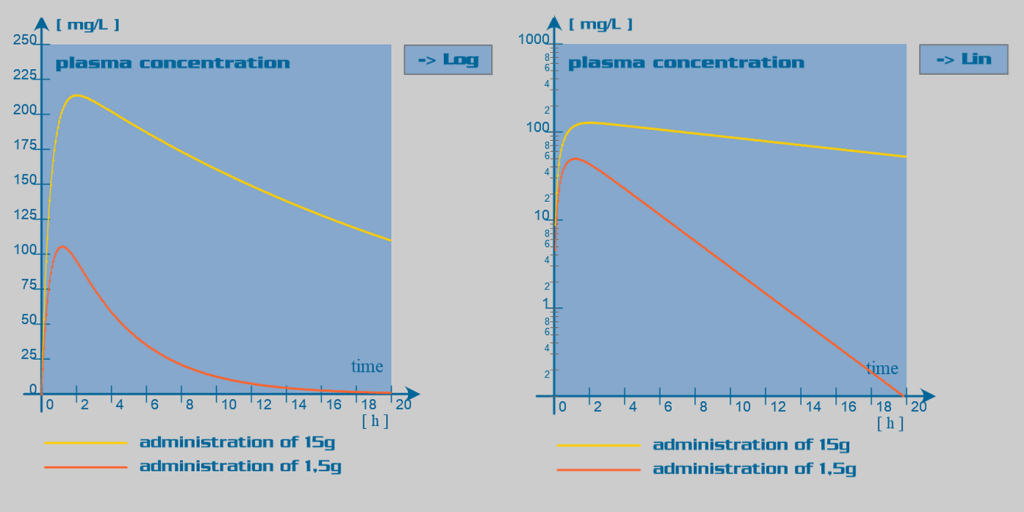Aspirin pharmacokinetic parameters
| Oral bioavailability (F) | 68% |
| Clearance (CL) | 39 L/h |
| Volume of Distribution (Vd) | 10.5 L |
| Half-life (t1/2) | 0.25 h |
Salicylate pharmacokinetic parameters
| Clearance (CL) | 3.6 L/h (may decrease to 0.6 L/h depending on dose) |
| Volume of Distribution (Vd) | 11.9 L |
| Half-life (t1/2) | 2h (may increase to 30h depending on dose) |
Description
Aspirin is used in the treatment of mild to moderate pain, inflammation, and fever. It is also used as an antiplatelet agent to prevent myocardial infarction, stroke and transient ischemic episodes.
Aspirin is absorbed rapidly from the stomach and intestine by passive diffusion. Aspirin is a prodrug, which is transformed into salicylate in the stomach, in the intestinal mucosa, in the blood and mainly in the liver. Salicylate is the active metabolite responsible for most anti-inflammatory and analgesic effects (but acetylsalicylate is the active moiety for the antiplatelet-aggregating effect). Gastrointestinal intolerance to salicylate observed in some patients has prompted the development of formulations with enteric coating.
Salicylate distributes rapidly into the body fluid compartments. It binds to albumin in the plasma. With increasing total plasma salicylate concentrations, the unbound fraction increases. Salicylate may cross the placental barrier and distributes into breast milk.
As mentioned above, aspirin is rapidly biotransformed into the active metabolite, salicylate. Therefore, aspirin has a very short half-life. Salicylate, in turn, is mainly metabolized by the liver. This metabolism occurs primarily by hepatic conjugation with glycin or glucuronic acid, each involving different metabolic pathways. The predominant pathway is the conjugation with glycin, which is saturable. With low doses of aspirin approximately 90% of salicylate is metabolized through this pathway. As the maximum capacity of this major pathway is reached, the other pathways with a lower clearance become more important. Therefore, the half-life of salicylate depends on the major metabolic pathway used at a given concentration and becomes longer with increasing dosage. Salicylate is said to follow nonlinear kinetics at the upper limit of the dosing range. Studies have shown that there is much inter-subject variation with respect to the relative contribution of the different salicylate metabolic pathways.
Urinary excretion of unchanged salicylate accounts for 10% of the total elimination of salicylate. Excretion of salicylate results of glomerular filtration, active proximal tubular secretion through the organic acid transporters and passive tubular reabsorption. Urinary excretion is markedly pH dependant and as the urinary pH rises from 5 to 8, the amount of free ionized salicylate excreted increases from 3% of the total salicylate dose to more than 80% (by ion trapping in the urine). Salicylate metabolites are also excreted in the urine.
Clinical implications
For sustained analgesic treatment, aspirin should be administered ever 4 hours, due to the short half-life of salicylate (2 hours).
Individual variability has been reported with salicylate therapy and may be due to the unusual and variable metabolism and elimination kinetics of salicylate.
The possibility of drug interactions must always be kept in mind (e.g. concomitant administration of aspirin with drugs normally secreted in the urine through the organic acid transporter). Concomitant disease, patient age and gender may influence the metabolism of aspirin, and should be considered before determining the dosage regimen. Aspirin should be used cautiously in patients with hepatic impairment because salicylate is essentially metabolized in the liver.
In case of intoxication, the half-life is greatly prolonged and therefore, the clinical signs of intoxication may persist for several days. Renal salicylate excretion can be enhanced by alkaline diuresis.


